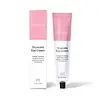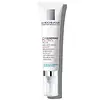What's inside
What's inside
 Key Ingredients
Key Ingredients

 Benefits
Benefits

 Concerns
Concerns

 Ingredients Side-by-side
Ingredients Side-by-side

Water
Skin ConditioningCoco-Caprylate
EmollientUrea
BufferingGlyceryl Stearate
EmollientBacillus Ferment
Skin ConditioningCetyl Alcohol
EmollientDalea Spinosa Seed Oil
MaskingTocopherol
AntioxidantPolyglyceryl-6 Stearate
EmollientStearic Acid
CleansingSimmondsia Chinensis Seed Oil
EmollientOryza Sativa Bran Oil
EmollientHexylresorcinol
AntimicrobialGlycerin
HumectantSodium Anisate
AntimicrobialSodium Levulinate
Skin ConditioningSodium Ascorbyl Phosphate
AntioxidantLactic Acid
BufferingGlyceryl Caprylate
EmollientPolyglyceryl-6 Behenate
Emulsion StabilisingGellan Gum
Ferulic Acid
AntimicrobialGlycyrrhiza Glabra Root Extract
BleachingSodium Phytate
Chamomilla Recutita Flower Extract
MaskingXanthan Gum
EmulsifyingCitric Acid
BufferingPotassium Sorbate
PreservativeWater, Coco-Caprylate, Urea, Glyceryl Stearate, Bacillus Ferment, Cetyl Alcohol, Dalea Spinosa Seed Oil, Tocopherol, Polyglyceryl-6 Stearate, Stearic Acid, Simmondsia Chinensis Seed Oil, Oryza Sativa Bran Oil, Hexylresorcinol, Glycerin, Sodium Anisate, Sodium Levulinate, Sodium Ascorbyl Phosphate, Lactic Acid, Glyceryl Caprylate, Polyglyceryl-6 Behenate, Gellan Gum, Ferulic Acid, Glycyrrhiza Glabra Root Extract, Sodium Phytate, Chamomilla Recutita Flower Extract, Xanthan Gum, Citric Acid, Potassium Sorbate
Water
Skin ConditioningIsocetyl Stearate
EmollientGlycerin
HumectantOctyldodecanol
EmollientPropylene Glycol
HumectantPentylene Glycol
Skin ConditioningDimethicone
EmollientAcrylamide/Sodium Acryloyldimethyltaurate Copolymer
Emulsion StabilisingCetearyl Alcohol
EmollientDimethicone/Vinyl Dimethicone Crosspolymer
Skin ConditioningCaffeine
Skin ConditioningIsohexadecane
EmollientSodium Hyaluronate
HumectantSodium Hydroxide
BufferingRetinol
Skin ConditioningRetinyl Linoleate
Skin ConditioningAdenosine
Skin ConditioningAmmonium Polyacryloyldimethyl Taurate
Emulsion StabilisingCaprylyl Glycol
EmollientCitric Acid
BufferingPolysilicone-8
Polysorbate 80
EmulsifyingPhenoxyethanol
PreservativeWater, Isocetyl Stearate, Glycerin, Octyldodecanol, Propylene Glycol, Pentylene Glycol, Dimethicone, Acrylamide/Sodium Acryloyldimethyltaurate Copolymer, Cetearyl Alcohol, Dimethicone/Vinyl Dimethicone Crosspolymer, Caffeine, Isohexadecane, Sodium Hyaluronate, Sodium Hydroxide, Retinol, Retinyl Linoleate, Adenosine, Ammonium Polyacryloyldimethyl Taurate, Caprylyl Glycol, Citric Acid, Polysilicone-8, Polysorbate 80, Phenoxyethanol
 Reviews
Reviews

Ingredients Explained
These ingredients are found in both products.
Ingredients higher up in an ingredient list are typically present in a larger amount.
Citric Acid is an alpha hydroxy acid (AHA) naturally found in citrus fruits like oranges, lemons, and limes.
Like other AHAs, citric acid can exfoliate skin by breaking down the bonds that hold dead skin cells together. This helps reveal smoother and brighter skin underneath.
However, this exfoliating effect only happens at high concentrations (20%) which can be hard to find in cosmetic products.
Due to this, citric acid is usually included in small amounts as a pH adjuster. This helps keep products slightly more acidic and compatible with skin's natural pH.
In skincare formulas, citric acid can:
While it can provide some skin benefits, research shows lactic acid and glycolic acid are generally more effective and less irritating exfoliants.
Most citric acid used in skincare today is made by fermenting sugars (usually from molasses). This synthetic version is identical to the natural citrus form but easier to stabilize and use in formulations.
Read more about some other popular AHA's here:
Learn more about Citric AcidGlycerin is already naturally found in your skin. It helps moisturize and protect your skin.
A study from 2016 found glycerin to be more effective as a humectant than AHAs and hyaluronic acid.
As a humectant, it helps the skin stay hydrated by pulling moisture to your skin. The low molecular weight of glycerin allows it to pull moisture into the deeper layers of your skin.
Hydrated skin improves your skin barrier; Your skin barrier helps protect against irritants and bacteria.
Glycerin has also been found to have antimicrobial and antiviral properties. Due to these properties, glycerin is often used in wound and burn treatments.
In cosmetics, glycerin is usually derived from plants such as soybean or palm. However, it can also be sourced from animals, such as tallow or animal fat.
This ingredient is organic, colorless, odorless, and non-toxic.
Glycerin is the name for this ingredient in American English. British English uses Glycerol/Glycerine.
Learn more about GlycerinWater. It's the most common cosmetic ingredient of all. You'll usually see it at the top of ingredient lists, meaning that it makes up the largest part of the product.
So why is it so popular? Water most often acts as a solvent - this means that it helps dissolve other ingredients into the formulation.
You'll also recognize water as that liquid we all need to stay alive. If you see this, drink a glass of water. Stay hydrated!
Learn more about Water